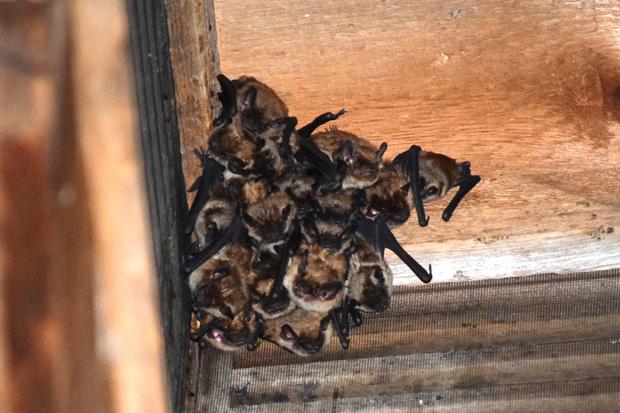Minnesota is home to two colonizing bat species, the little brown bat (Myotis Lucifugus) and the big brown bat (Eptesicus Fuscus). These are both nocturnal mammals that feed on insects from dusk to dawn. Bats navigate and locate food using echolocation, or the sending out of high frequency sound waves. When these waves strike an object they echo back to the bat, revealing the “shape” of their environment and the things in it.
Hibernation and reproduction is timed similarly for both colonial bat species. Mating occurs in the fall, shortly before hibernation. Big brown bats will often overwinter in attics, while little brown bats are more likely to migrate to winter harborages like mines, caves and similar environments. During hibernation, bats will hang upside down, periodically waking and moving to a more comfortable location, usually within the same colony site.
Females ovulate upon exiting hibernation in the spring, giving birth to a pup (or occasionally a set of two) in the early summer, or roughly 60 days later. These pups will become capable of flight after 3-5 weeks, but will initially be less maneuverable than adults. By late summer they are capable of being fully independent. Bats are a protected species, with eviction from roosting sites prohibited during this young-rearing time to prevent bat mortality. The blackout period extends from June 1st to August 15th and is strictly observed by reputable wildlife control professionals.
The little brown bat can be recognized by it’s pointy ears, toe hair, and brown coloration. They are 3-5 inches in length, 8-11 inches in wingspan, and typically weigh in at ½ ounce or less. They live in colonies of 12-1000 individuals, and can live as long as 30 years, though most live significantly shorter lifespans.

Big brown bats have less in common with the little brown bat than their names imply. They generally range from tan to dark brown in fur color, with non-fur covered areas in black. Their ears have a rounded appearance then come to a tip. A normal wingspan for these bats is about 13-16 inches with a body length of nearly 5 inches and a weight of ½-¾ ounce. Maternal colony size can vary from as few as 20 bats to several hundred. This species is capable of surviving more than 20 years, but again, they usually survive less.
An additional 5 species of bats that reside in our region, mostly solitary tree-dwelling species that would seldom be seen in a home or business. These are the Hoary bat, Northern long-eared bat, Tricolored bat, Silver-haired bat, and the Eastern Red Bat. Recently, individual evening bats have also been spotted in Minnesota for the first time.
